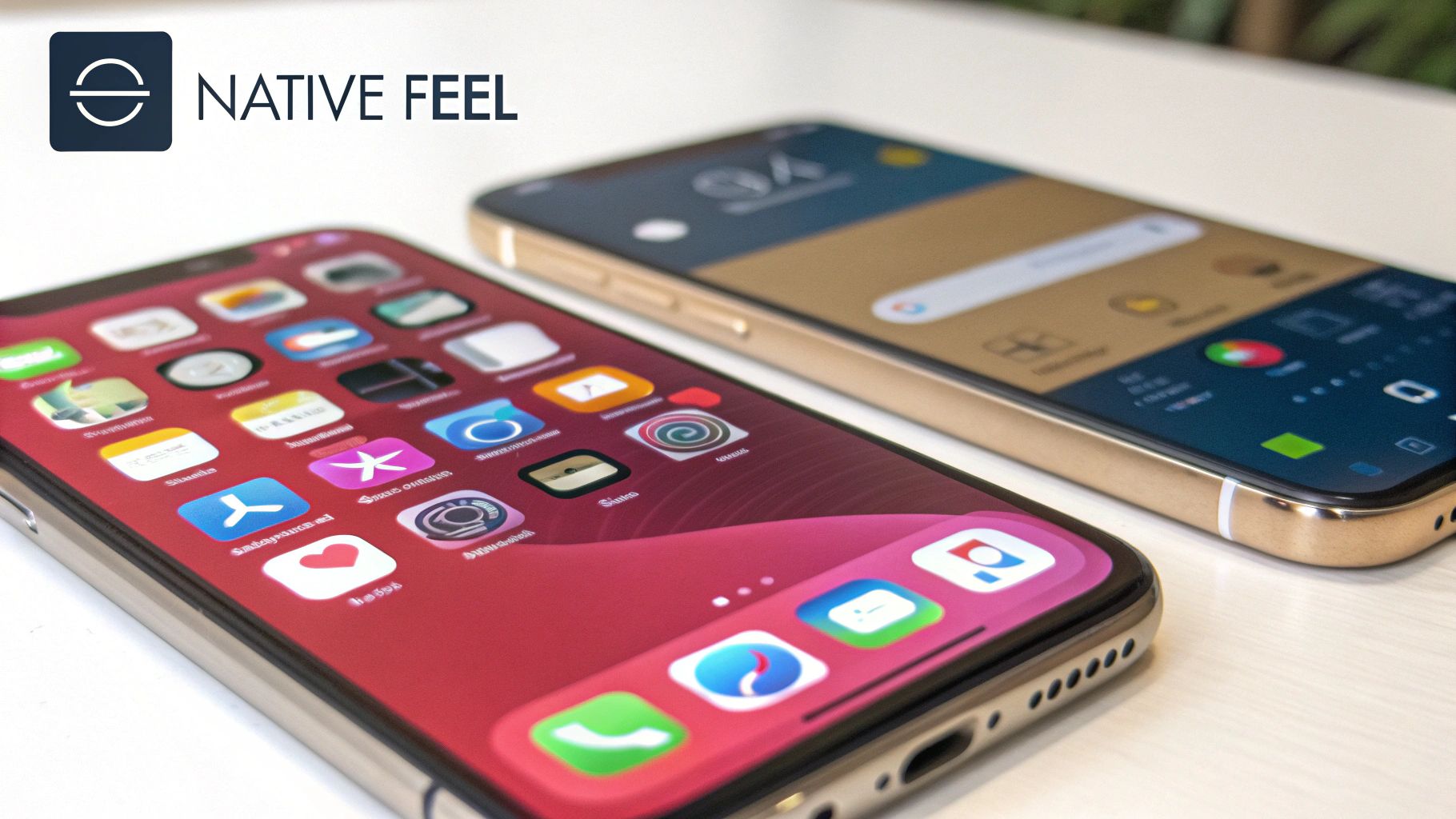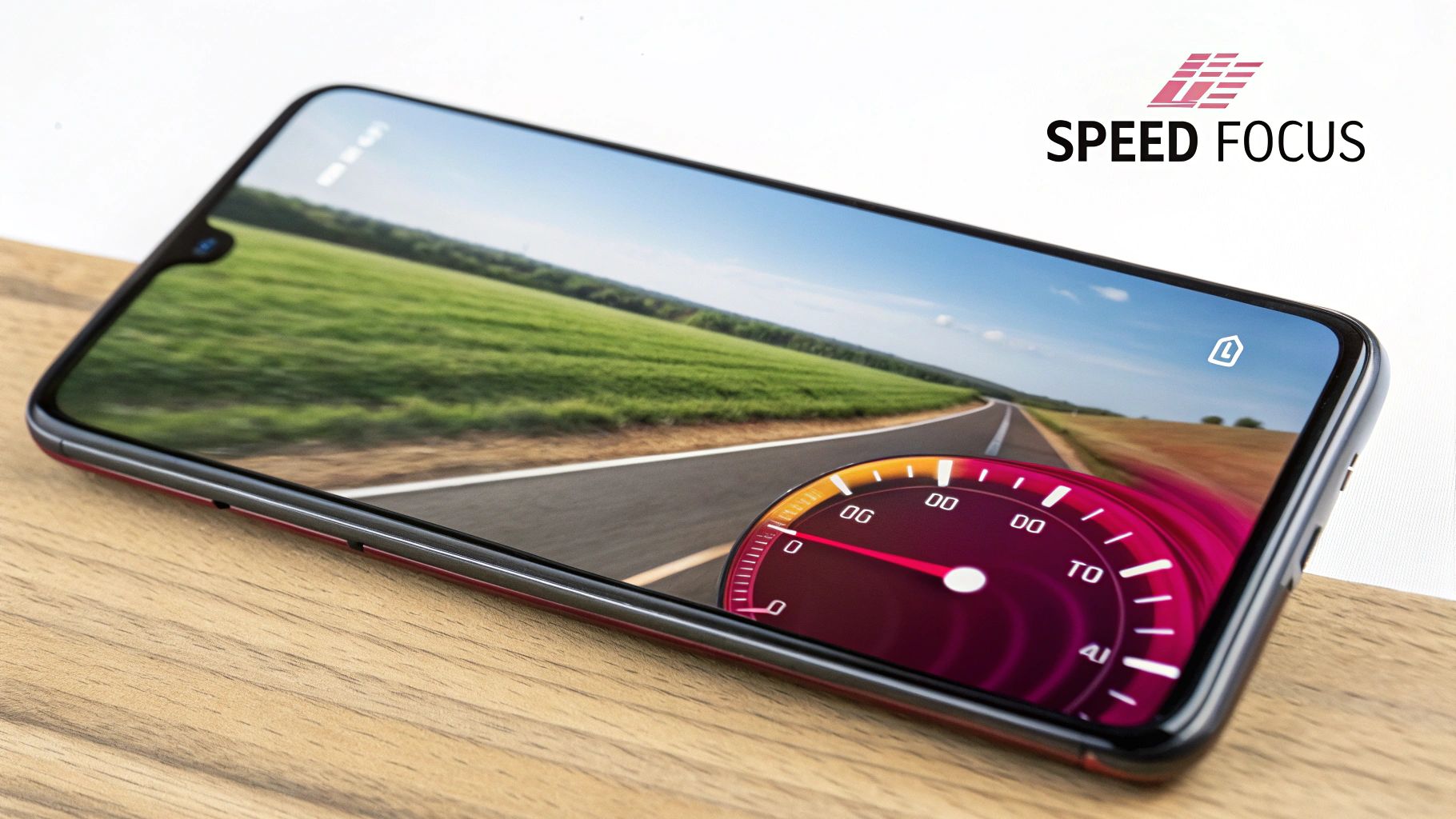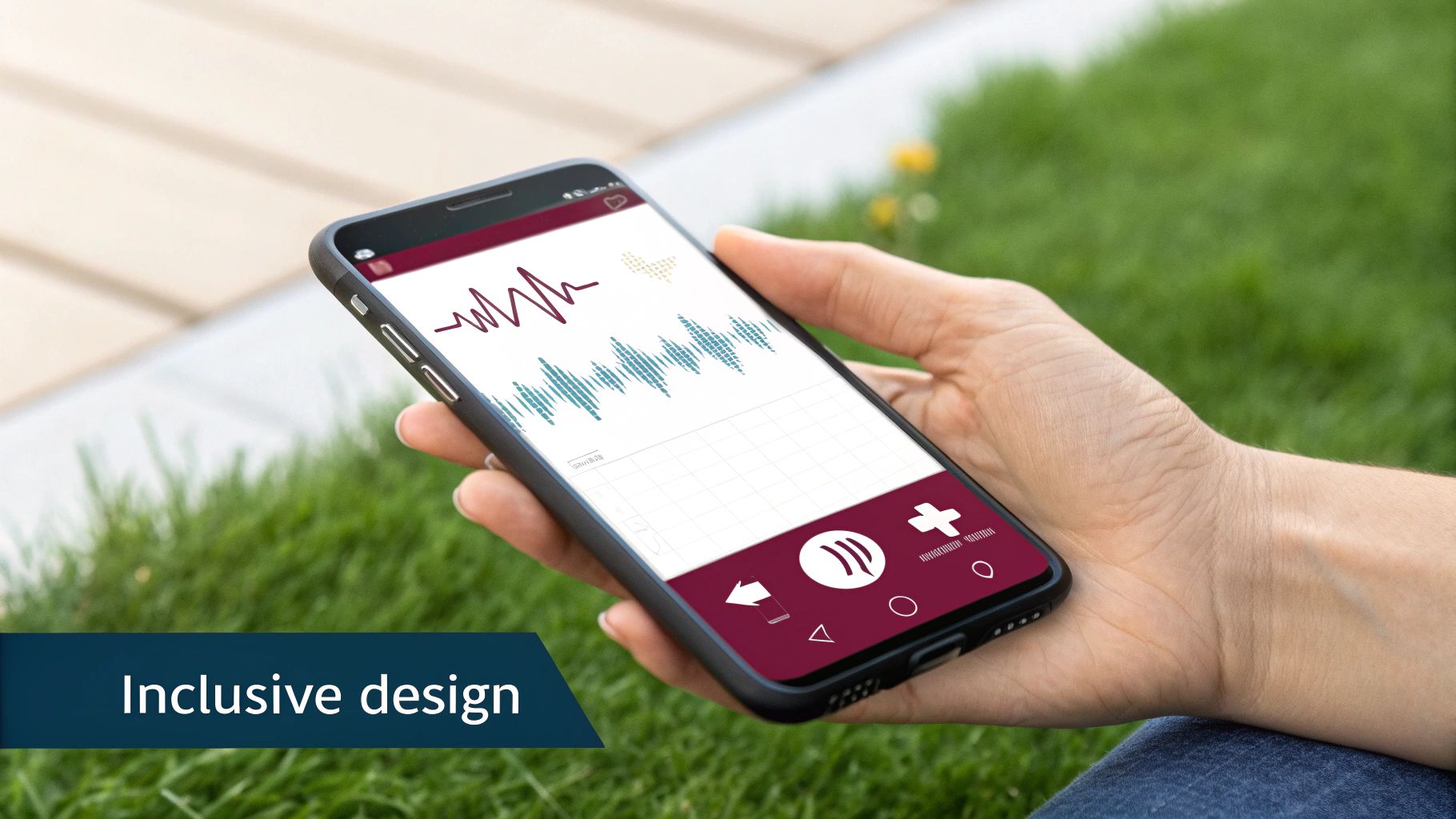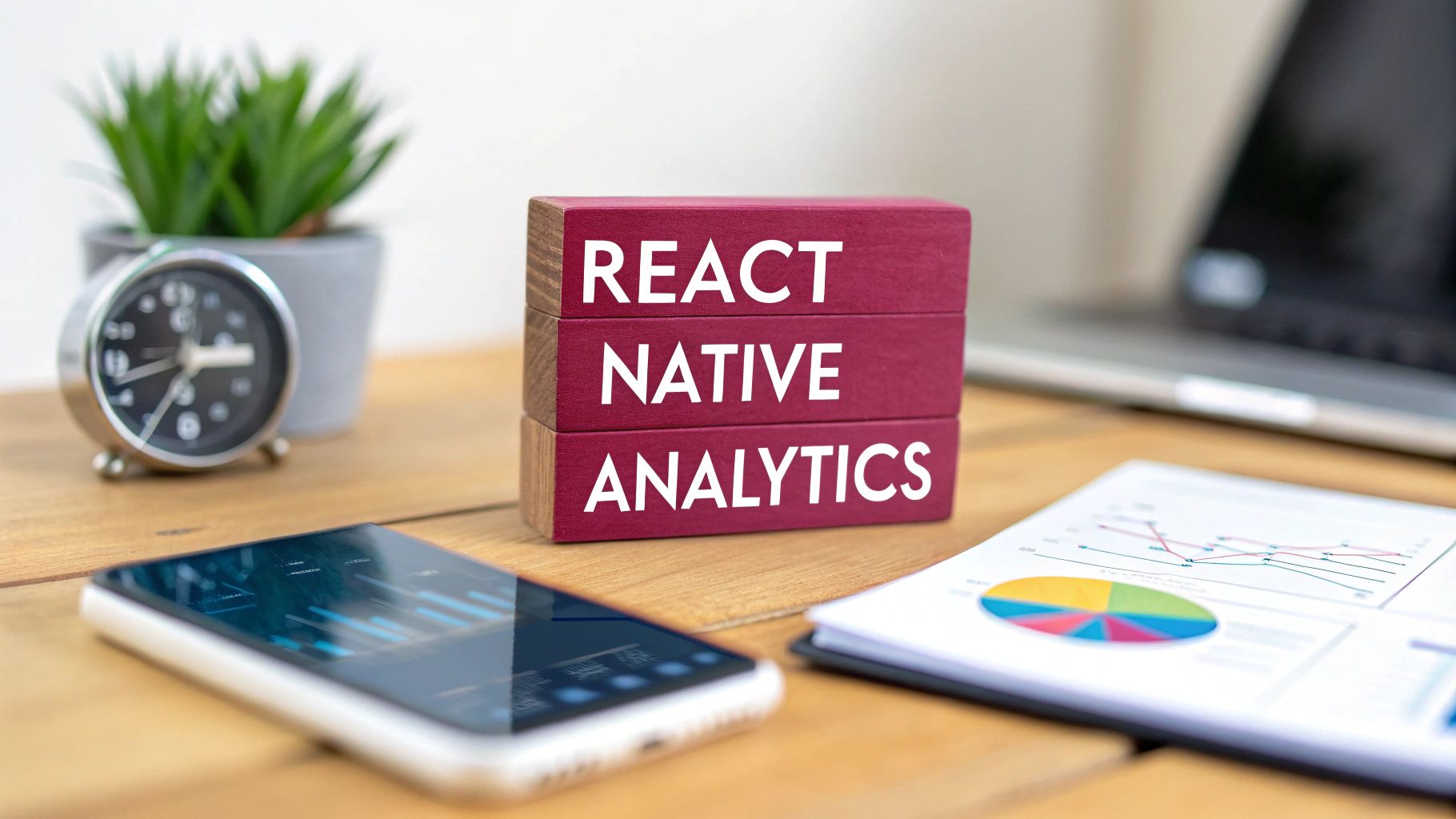The mobile landscape is fiercely competitive. A functional app is not enough; success demands excellence across the entire development lifecycle, from initial concept to post-launch updates. Simply launching an app is no longer a guaranteed path to success. Today’s users expect seamless performance, robust security, intuitive design, and continuous improvement, which requires a strategic approach grounded in proven methodologies.
This guide cuts through the noise to provide a definitive list of the most critical mobile app development best practices. We will move beyond generic advice and explore each practice with actionable insights, real-world examples, and specific implementation details. You will learn how to build a superior product while simultaneously streamlining your workflow, reducing technical debt, and positioning your app for long-term growth.
Mastering these principles is essential for any developer, product manager, or engineer aiming for high user ratings and market leadership. From architecting for scalability and ensuring comprehensive security to implementing a robust CI/CD pipeline and leveraging powerful tools for instant updates, these are the strategies that separate top-tier apps from the rest. Let’s dive into the core practices that define modern, high-quality mobile applications.
1. Master User-Centered Design (UCD) to Build Apps People Love
User-Centered Design (UCD) is a foundational philosophy that anchors the entire development lifecycle around the end-user. Instead of building features based on internal assumptions, UCD is an iterative process of understanding user needs, behaviors, and motivations through research and feedback. This ensures the final product is not just functional but also intuitive, accessible, and genuinely valuable to its target audience.

This methodology is a critical mobile app development best practice because it directly correlates to user retention and satisfaction. Apps like Duolingo succeed because their gamified learning path was designed around user motivation, not just language curriculum. Similarly, Uber’s streamlined booking flow was born from a deep understanding of the user’s need for a simple, fast, and transparent process. Adopting UCD means shifting from a feature-first to a user-first mindset.
How to Implement User-Centered Design
- Conduct Pre-Design Research: Before writing a single line of code, engage with your target audience through surveys, interviews, and focus groups to gather qualitative insights.
- Create User Personas and Journey Maps: Develop detailed profiles of your ideal users and map out their potential interactions with your app to identify pain points and opportunities.
- Prioritize Accessibility: From the start, design for a diverse range of users, including those with disabilities. This includes using sufficient color contrast, supporting screen readers, and ensuring tappable targets are large enough.
- Use Analytics to Validate Assumptions: Implement analytics tools to track user behavior and validate your design choices with quantitative data. A/B test key elements like button placement or onboarding flows to optimize engagement.
2. Adhere to Platform-Specific Design Guidelines
Adhering to established platform guidelines is a crucial mobile app development best practice that ensures your application feels native and intuitive to users. Each operating system, like iOS and Android, has a distinct design language, such as Apple’s Human Interface Guidelines and Google’s Material Design. Following these rules for navigation, controls, and visual elements helps users feel instantly at home, as the app behaves exactly as they expect.

This practice goes beyond mere aesthetics; it’s about leveraging established user behavior patterns to create a seamless experience. For example, WhatsApp adapts its navigation to each platform, using a bottom tab bar on iOS and a top tab bar on Android. This respect for platform conventions reduces the user’s learning curve, improves usability, and increases the likelihood of a positive reception. Ignoring these guidelines can make an app feel foreign and clunky, leading to user frustration and abandonment.
How to Implement Platform-Specific Design
- Study and Bookmark Official Guidelines: Deeply familiarize yourself with Apple’s Human Interface Guidelines and Google’s Material Design. Keep these resources accessible for quick reference throughout the design and development process.
- Use Platform-Specific UI Kits: Leverage official design templates and UI kits for tools like Figma or Sketch. These kits provide pre-built components that comply with platform standards, accelerating the design workflow.
- Consider Platform Behavior Patterns: Recognize that user expectations differ. iOS users are accustomed to swipe-back gestures, while Android users rely on a system-wide back button. Your app’s flow should accommodate these ingrained habits.
- Test on Real Devices: Simulators are useful, but testing on actual iOS and Android devices is essential to truly understand the look, feel, and performance of your app within its native environment.
3. Prioritize Rigorous Performance Optimization
Performance optimization is the practice of systematically refining an app to ensure it runs quickly, smoothly, and efficiently on a user’s device. This involves minimizing load times, reducing battery consumption, ensuring fluid animations, and using memory effectively. In a competitive market, a slow or unresponsive app is one of the fastest ways to lose users, making this a non-negotiable mobile app development best practice.

This discipline is crucial because perceived performance directly impacts user experience and retention. For example, Facebook’s lazy loading of news feed content ensures a fast initial startup, while Netflix’s adaptive streaming provides a seamless viewing experience even on weak connections. These optimizations prevent user frustration and abandonment by making the app feel snappy and reliable, regardless of network conditions or device capabilities.
How to Implement Performance Optimization
- Profile and Monitor Continuously: Regularly use profiling tools like Xcode Instruments or Android Profiler to identify bottlenecks in CPU, memory, and network usage. Continuously monitor real-world performance to catch regressions.
- Optimize Asset Delivery: Implement image compression using modern formats like WebP, and lazy-load images and other non-critical assets to speed up initial screen rendering.
- Minimize Network Requests: Bundle multiple API calls into a single request where possible and leverage caching strategies to reduce the need to fetch data from the server repeatedly.
- Refine Data Handling: Ensure database queries are efficient and data structures are optimized for quick access and manipulation, avoiding unnecessary processing on the main thread. Understanding what to measure is key; you can explore the top app performance metrics on codepushgo.com to get started.
4. Robust Security Implementation
A robust security implementation is a non-negotiable mobile app development best practice that protects user data, prevents unauthorized access, and builds foundational trust with your audience. It involves a multi-layered approach that includes secure data transmission, hardened authentication protocols, and proactive defense against known vulnerabilities. In an era where data breaches are common, failing to prioritize security can lead to reputational damage, legal penalties, and a complete loss of user confidence.

This practice is essential because mobile devices are inherently personal, storing sensitive information from financial details to private communications. Apps like Signal exemplify this by implementing end-to-end encryption, ensuring only the sender and receiver can read messages. Similarly, banking apps use multi-factor authentication (MFA) to create a formidable barrier against account takeovers. A secure app isn’t just a feature; it’s a core promise to your users that their digital lives are safe with you. You can learn more about app security standards on codepushgo.com.
How to Implement Robust Security
- Secure Data In Transit and At Rest: Always use HTTPS with TLS to encrypt data moving between the app and the server. For data stored on the device, leverage platform-specific secure storage systems like the iOS Keychain or Android’s EncryptedSharedPreferences.
- Implement Secure Authentication: Utilize proven authentication frameworks like OAuth 2.0 or OpenID Connect. Enforce strong password policies and implement MFA wherever possible to add a critical layer of protection.
- Protect Against Common Vulnerabilities: Adhere to guidelines from the OWASP Mobile Security Project to guard against threats like insecure data storage, poor authorization, and code tampering. Regularly scan your codebase for known vulnerabilities.
- Harden Your APIs: Secure the APIs your app consumes by implementing rate limiting, proper access controls, and input validation to prevent injection attacks and other server-side exploits.
5. Implement a Comprehensive Testing Strategy
A comprehensive testing strategy is an essential mobile app development best practice that involves multiple layers of validation to ensure quality, reliability, and performance. This approach goes beyond basic functionality checks, creating a robust quality assurance pipeline that includes unit tests for individual components, integration tests for component interactions, and UI tests for the end-user experience. A multi-layered strategy is crucial for identifying bugs early, reducing development costs, and preventing negative user reviews post-launch.
This meticulous approach is non-negotiable for delivering a stable and polished application. Companies like Spotify and Netflix exemplify this by using sophisticated automated testing frameworks to verify app behavior across countless device and OS combinations. Their success hinges on delivering a seamless experience, which is only possible through rigorous, continuous testing. Adopting such a strategy ensures your app can handle real-world usage, from ideal conditions to edge cases and error states.
How to Implement a Comprehensive Testing Strategy
- Automate Repetitive Testing Tasks: Use frameworks like Appium or XCUITest to automate UI tests. This frees up your QA team to focus on more complex exploratory testing and user experience validation.
- Establish a CI/CD Pipeline: Integrate your testing suites into a Continuous Integration/Continuous Deployment (CI/CD) pipeline. This automatically runs tests on every code commit, catching regressions and bugs instantly.
- Use Cloud-Based Device Farms: Leverage services like AWS Device Farm or BrowserStack to test your app on a vast array of real devices, screen sizes, and OS versions, ensuring broad compatibility. For more details, explore these mobile app testing best practices.
- Prioritize Real Device Testing: While simulators are useful for initial development, always validate final builds on physical devices to accurately test performance, gestures, and hardware interactions.
6. Prioritize Offline Functionality and Data Synchronization
In an always-on world, reliable connectivity is never a guarantee. Prioritizing offline functionality means designing your app to remain useful even without an internet connection. This involves local data storage, intelligent caching, and a robust synchronization strategy to ensure a seamless user experience, regardless of network availability. This mobile app development best practice transforms a dependency into a strength, boosting user satisfaction and retention.
This local-first approach is crucial because it makes an app feel faster and more dependable. Apps like Spotify allow users to download playlists for offline listening, while Google Maps enables navigation with pre-downloaded maps. These features aren’t just conveniences; they are core to the user experience, allowing the app to function in subways, on planes, or in remote areas. The goal is to gracefully handle network interruptions so the user barely notices them.
How to Implement Offline Functionality and Synchronization
- Implement Local-First Architecture: Store data on the device first and synchronize it with the server in the background. This ensures the UI is always responsive, as it reads directly from a local database like SQLite or Realm.
- Use Intelligent Caching: Cache frequently accessed data, images, and other assets. This reduces load times and data consumption when online and ensures content is available when offline.
- Provide Clear Offline Indicators: Visually inform users when they are offline and when data is pending synchronization. A simple banner or icon helps manage user expectations and prevents confusion.
- Handle Sync Conflicts Gracefully: Develop a clear strategy for resolving data conflicts that may occur when a user makes changes offline while the server-side data is also updated. Options include “last write wins” or prompting the user to resolve the conflict manually.
7. Adopt a Scalable Architecture and Prioritize Clean Code
A scalable architecture and clean code are the twin pillars of long-term app viability and success. This practice involves structuring the application’s codebase in a way that is logical, maintainable, and prepared for future growth. By adopting established architectural patterns like Model-View-Controller (MVC), Model-View-Presenter (MVP), or Model-View-ViewModel (MVVM), development teams create a clear separation of concerns that simplifies updates, debugging, and feature additions.
This discipline is one of the most crucial mobile app development best practices because it prevents the accumulation of “technical debt.” Apps like Netflix and Uber can handle massive scale and rapid feature evolution because they are built on robust, service-oriented architectures. Investing in a clean, well-documented, and scalable foundation from day one allows your team to build efficiently and adapt to market changes without needing a complete rewrite down the line.
How to Implement Scalable Architecture and Clean Code
- Choose an Appropriate Architectural Pattern: Select an architecture (e.g., MVVM, VIPER, MVI) that fits your app’s complexity and your team’s expertise. This enforces a consistent structure and separation of business logic, data, and UI.
- Adhere to SOLID Principles: Follow the five SOLID principles of object-oriented design to create modules that are maintainable, flexible, and easy to understand. This makes the codebase resilient to change.
- Enforce Consistent Coding Standards: Establish and automate coding standards for naming conventions, formatting, and commenting. This consistency is vital for team collaboration and onboarding new developers.
- Conduct Rigorous Code Reviews: Implement a mandatory code review process for all changes. This practice helps catch bugs early, share knowledge across the team, and maintain high standards of code quality.
8. Prioritize Analytics for Data-Driven Decision Making
Analytics is the practice of systematically collecting, measuring, and analyzing data to understand user behavior, app performance, and business outcomes. Instead of relying on guesswork, this mobile app development best practice provides the quantitative evidence needed to make informed decisions. It transforms product development from a series of assumptions into a cycle of hypothesis, testing, and validation, ensuring that every feature and optimization is rooted in real-world user interaction.
This data-driven approach is what allows companies to thrive in competitive markets. For example, Netflix analyzes viewing behavior to inform content acquisition and its powerful recommendation engine, while Uber uses ride data to optimize pricing and driver allocation. Adopting a similar mindset means you stop asking “What do we think users want?” and start asking “What does the data show users are doing?”. This shift is crucial for optimizing user experience and achieving business goals.
How to Implement Analytics and Data-Driven Decision Making
- Define Clear KPIs and Success Metrics: Before launching, identify key performance indicators (KPIs) that align with your business objectives. This could include daily active users (DAU), retention rates, session duration, or conversion rates for specific actions.
- Implement Privacy-Compliant Tracking: Integrate analytics tools that respect user privacy and comply with regulations like GDPR and CCPA. Clearly communicate your data policies and provide users with control over their information.
- Combine Quantitative and Qualitative Data: While analytics provide the “what,” qualitative feedback from surveys and user interviews provides the “why.” Combine both to get a complete picture of the user experience. You can learn more by exploring various analytics tools for React Native.
- Create Actionable Dashboards and Reports: Visualize data in dashboards that are easy to understand for all stakeholders, from developers to marketers. Set up real-time monitoring and alerts for critical events, like a sudden drop in user engagement or a spike in app crashes.
9. Prioritize Accessibility and Inclusive Design
Accessibility and Inclusive Design are not optional add-ons; they are essential mobile app development best practices for creating applications that everyone, including people with disabilities, can use effectively. This approach involves proactively designing and building features that support diverse abilities, such as vision impairment, hearing loss, motor difficulties, and cognitive differences. It’s about building empathy into the very fabric of your app to ensure an equitable experience for all users.
This commitment to inclusivity directly expands your market reach and enhances brand reputation. Apple’s deep integration of VoiceOver and Google’s accessibility features in Android are prime examples of how platform-level support enables developers to build universally usable products. Similarly, the “Be My Eyes” app, which connects blind users with sighted volunteers, showcases how accessibility-first thinking can create profoundly impactful solutions. Designing inclusively from the start prevents costly retrofitting and demonstrates a core respect for every potential user.
How to Implement Accessibility and Inclusive Design
- Follow WCAG 2.1 Guidelines: Aim for at least Level AA conformance of the Web Content Accessibility Guidelines (WCAG) as a baseline for your app. This covers aspects like color contrast, text resizing, and keyboard navigation.
- Use Semantic Elements and Labels: Ensure all interactive elements like buttons and input fields have clear, descriptive labels that can be read by screen readers. Use semantic markup to define the structure and purpose of content.
- Test with Real-World Tools: Go beyond simulators. Manually test your application using built-in accessibility tools like Apple’s VoiceOver and Android’s TalkBack to understand the actual user experience.
- Consider Diverse User Needs: Design for more than just screen reader compatibility. Include features like high-contrast modes, reduced motion options, and alternative methods for completing tasks to support users with various cognitive and motor needs.
10. Implement Continuous Integration and Deployment (CI/CD)
Continuous Integration and Continuous Deployment (CI/CD) is an essential DevOps practice that automates the build, test, and release stages of your app’s lifecycle. By merging code changes into a central repository frequently (CI) and then automatically pushing those changes through testing and into production (CD), teams can deliver updates faster and more reliably. This automation is a critical mobile app development best practice because it minimizes manual errors and shortens release cycles.
This methodology keeps your development velocity high without sacrificing quality. For example, tech giants like Netflix and Spotify rely heavily on automated CI/CD pipelines to deploy updates multiple times a day, ensuring they can respond to market demands and fix bugs with incredible speed. Adopting a CI/CD workflow transforms your release process from a high-stress, manual event into a routine, predictable, and low-risk operation.
How to Implement CI/CD
- Start Simple and Expand: Begin by automating the build and unit testing process. Once that is stable, gradually add more complex stages like UI testing, security scans, and automated deployment to app stores.
- Leverage Version Control: Use a version control system like Git for all code, scripts, and configuration files. This ensures every change is tracked and that your pipeline is reproducible.
- Build a Comprehensive Test Suite: Your CI pipeline’s effectiveness depends on the quality of your automated tests. Include a mix of unit, integration, and end-to-end tests to catch regressions before they reach users.
- Use Feature Flags for Controlled Rollouts: Deploy new features to production behind feature flags. This allows you to enable functionality for a small subset of users, test its performance, and roll it back instantly if issues arise. To learn more about this process, you can explore this CI/CD pipeline tutorial on codepushgo.com.
Best Practices Comparison for Mobile App Development
| Item | Implementation Complexity 🔄 | Resource Requirements ⚡ | Expected Outcomes 📊 | Ideal Use Cases 💡 | Key Advantages ⭐ |
|---|---|---|---|---|---|
| User-Centered Design (UCD) | Moderate to High – requires ongoing iteration and user testing | High – user research, testing resources | Higher user satisfaction, engagement, retention | Apps prioritizing UX and diverse user needs | Better UX, early problem detection, accessibility compliance |
| Platform-Specific Design Guidelines | Moderate – separate design for each platform | Medium to High – platform expertise needed | Consistent native feel, better app store approval | Apps targeting multiple platforms natively | Familiar UX, native performance, easier updates |
| Performance Optimization | High – specialized tools and continuous monitoring | Medium to High – dev expertise, profiling tools | Faster load, smoother experience, better retention | Apps needing fast, efficient user experience | Improved performance, reduced churn, cost savings |
| Robust Security Implementation | High – complex security layers and updates | High – security expertise and tools | Protected data, regulatory compliance, user trust | Apps handling sensitive data and transactions | Enhanced trust, compliance, breach prevention |
| Comprehensive Testing Strategy | High – multiple testing layers and maintenance | High – automated tools, testing expertise | Reduced bugs/crashes, improved stability | Apps requiring high reliability and quality | Better stability, faster development cycles, improved UX |
| Offline Functionality & Sync | High – complex data syncing and offline handling | Medium to High – development and testing | Seamless use offline, improved engagement | Apps used in low connectivity environments | Better UX offline, reduced data costs, competitive edge |
| Scalable Architecture & Clean Code | Moderate to High – upfront planning and ongoing refactoring | Medium – developer discipline and collaboration | Easier maintenance, faster feature addition | Growing apps, teams needing maintainable code | Reduced debt, better collaboration, code reusability |
| Analytics & Data-Driven Decisions | Moderate to High – tracking setup and analysis | Medium – analytics tools and expertise | Data-driven improvements, increased conversion | Apps focused on growth and optimization | Informed decisions, better UX, revenue growth |
| Accessibility & Inclusive Design | Moderate – additional development and testing | Medium – accessibility expertise | Expanded reach, legal compliance | Apps targeting diverse user abilities | Larger user base, compliance, enhanced usability |
| Continuous Integration & Deployment (CI/CD) | High – initial setup and ongoing maintenance | Medium to High – DevOps tools and expertise | Faster releases, improved code quality | Teams aiming for rapid, reliable delivery | Faster cycles, fewer errors, improved collaboration |
Putting It All Together: Your Blueprint for Mobile Excellence
Navigating the complex landscape of mobile app development requires more than just functional code. It demands a holistic commitment to quality, user satisfaction, and strategic foresight. The journey from an initial concept to a market-leading application is built upon a foundation of established mobile app development best practices, and the ten pillars we’ve explored are your blueprint for achieving that success.
Think of these practices not as a sequential checklist but as interconnected disciplines that reinforce one another. A User-Centered Design (UCD) approach is incomplete without considering Accessibility. A Scalable Architecture is only as strong as its Security Implementation. And even the most optimized, well-tested application can fall short without a modern CI/CD pipeline to deliver continuous value.
From Good to Great: Integrating Best Practices
The core takeaway is that excellence is an active process, not a final destination. By weaving these principles into your daily workflow, you cultivate a culture of quality that pays dividends in user retention, positive reviews, and long-term viability.
- User-First Mindset: Always start with the user. UCD, platform-specific guidelines, and accessibility are not afterthoughts; they are the starting point for creating intuitive and delightful experiences.
- Technical Foundation: Build for the future. A scalable architecture, clean code, robust security, and meticulous performance optimization ensure your app can grow and adapt without costly refactoring.
- Operational Agility: Stay ahead of the curve. A comprehensive testing strategy, integrated analytics, and a powerful CI/CD pipeline give your team the data and speed needed to respond to market changes and user feedback effectively.
Adopting this comprehensive approach transforms your development process. It moves you from simply building features to crafting superior mobile experiences that solve real problems, earn user trust, and drive meaningful business outcomes. The most successful apps are not just coded; they are engineered with precision, empathy, and a relentless focus on quality. This is the definitive path to mastering modern mobile app development best practices.
Ready to supercharge your CI/CD pipeline and deployment agility? CodePushGo allows you to instantly deploy updates, bug fixes, and new features to your React Native apps without waiting for app store reviews. Embrace one of the most powerful mobile app development best practices by implementing Over-The-Air (OTA) updates today. Explore CodePushGo and see how you can ship faster and smarter.




